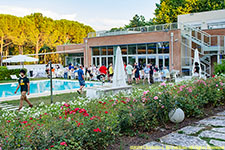
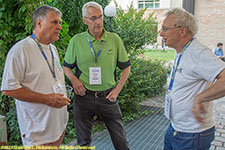
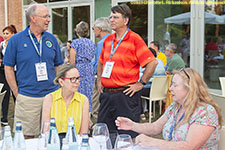
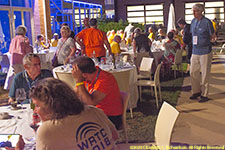
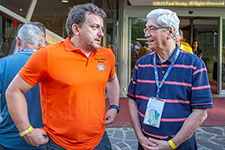
Emilia-Romagna, in northern Italy, comprises the historical regions of Emilia and Romagna, with Bologna as its capital. It is one of the wealthiest and most-developed regions in Europe, and a cultural, economic, and tourist center. Bologna is home to the University of Bologna, the oldest univeristy in the world. The area is a center for food and automobile production. Most of the region lies in the plain of the Po River.
WRTC 2022, the "Olympics of amateur radio", was held in Emilia-Romagna in July, 2023, having been postponed for a year due to the Covid pandemic. The competition had its headquarters in Castel San Pietro Terme at the Anusca Palace Hotel.
W1UE (Dennis) was a team captain for North America district 1, with Paul (K1XM) as his team mate, the first WRTC for both of them. Their assigned station, I46C, was in an un-air-conditionned gymnasium. Nodir, EY8MM, was their refereee. The team did not win, but they say they had more fun than anyone else did.
Giglielmo Marconi's House in Sasso Marconi and the Marconi Foundation house the museum and mausoleum of Marconi. The tomb is adjacent to the 17th century Villa Griffone (Villa Marconi) about 15km from Bologna. The museum celebrates the discoveries and advances of Marconi in the fields of electricity and communications and houses some of the scientific instruments and products used and developed by Marconi and others,...
... including his laboratory.
Museum Pelagalli in Bologna, housing over 2000 original, working electronic devices which tell the story of audiovisual communications.
Bologna is the largest city and capital of Emilio-Romagna, with a population of one million. It is famous for its rich cuisine. We took an egg pasta-making course at FICO Eataly World. We made tortellini, capellini, farfalle, and fettucine,...
...followed by a tasting tour of Italian delicacies from different regions: Mortadella, Prosciutto, Parmigiano Reggiano, pasta, and gelato.
The city is on the edge of the Po plain at the foot of the Apennine Mountains.
The well-preserved historical center is known for its porticoes.
We took the Bologna City Red Bus Tour from the Piazza Maggiore.
Ravenna was the capital of the Western Roman Empire from 408 for most of the fifth century until its collapse in 476. It is connected to the Adriatic Sea by the Canadiano Canal. It is known for its well-preserved late Roman and Byzantine architecture. It is famous for its mosaics.
The octagonal Basilica di San Vitale is an example of early Christian Byzantine architecture from the 6th century. Construction began in 526. It is famous for its Byzantine mosaics. The Baroque frescoes in the dome were painted between 1778 and 1782.
Galla Placidia's Mausoleum; Galla Placidia was the daughter of Roman emperor Theodosius I and his second wife Galla. The mausoleum is a UNESCO World Heritage Site. It never served as her tomb, but was originally built as a chapel to Lawrence of Rome. It is covered with spectacular mosaics. The empress is actually buried in Rome.
Dante's tomb is a neoclassical 18th century monument built over the tomb of Dante Alighieri.
The Basilica of Sant'Apollinare Nuovo was built by the Ostrogothic king Theodoric the Great as his palace chapel during the first quarter of the sixth century. The marble portico in front was added in the 16th century, and the bell tower dates from the 9th or tenth century.
©2023 Mermaid Underwater Photographic. All Rights Reserved.
This page sponsored by Mermaid Underwater Photographic. Contact us at mermaid@underwater.org.
Last modified 17 August 2023